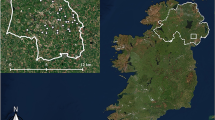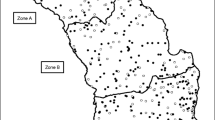Abstract
Wildlife disease management often relies on altering population abundance and density to reduce the susceptible host population. Understanding the vital rates and ecology that influence wildlife population dynamics is important for assessing the outcomes of management policies. European badgers (Meles meles) in Ireland have historically been managed for bovine tuberculosis (TB) using culling, but are now being vaccinated instead. We used data from 6847 badgers submitted for postmortem examination from 2016 to 2018 to inform population monitoring of badgers under this management change. Female reproductive status varied strongly by month, and a considerable proportion (25–40%) of females had evidence of premature cessation of lactation. Teat lengths may offer a crude guideline for rapid antemortem assessment of probable reproductive status. Body weight for males and females declined throughout the capture period, and we report reference ranges for normal male and female body weight during each month. Increasing body weight was associated with an increased odds of pregnancy (OR 2.52, 95% CI 2.20–2.93, p < 0.001). Prior capturing at the sett where a badger was captured did not affect the odds of pregnancy (OR = 0.99, 95% CI 0.96–1.03, p = 0.77) or influence litter size (β = − 0.0012, SE = 0.014, p = 0.93). Assessing changes in badger reproduction will ensure that management is adapted for a badger population likely to expand and contribute to a successful TB eradication program in Ireland.


Similar content being viewed by others
References
Ahnlund H (2009) Sexual maturity and breeding season of the badger, Meles meles in Sweden. J Zool 190:77–95
Anderson RM, Jackson HC, May RM, Smith AM (1981) Population dynamics of fox rabies in Europe. Nature 289:765–771
Audy-Relexans M-C (1972) Le cycle sexuel du blaireau mâle (Meles meles L.). Ann Biol Anim Biochim Biophys 12:355–366
Byrne AW, Sleeman DP, O’Keeffe J, Davenport J (2012) The ecology of the European badger (Meles meles) in Ireland: a review. Biol Environ Proc R Ir Acad 112:105–132
Byrne AW, O’Keeffe J, Sleeman DP, Davenport J, Martin SW (2013) Impact of culling on relative abundance of the European badger (Meles meles) in Ireland. Eur J Wildl Res 59:25–37
Byrne AW, Quinn JL, O’Keeffe JJ, Green S, Sleeman DP, Martin SW, Davenport J (2014) Large-scale movements in European badgers: has the tail of the movement kernel been underestimated? J Anim Ecol 83:991–1001
Byrne AW, Fogarty U, O’Keeffe J, Newman C (2015a) In situ adaptive response to climate and habitat quality variation: spatial and temporal variation in European badger (Meles meles) body weight. Glob Chang Biol 21:3336–3346
Byrne AW, O’Keeffe J, Fogarty U, Rooney P, Martin SW (2015b) Monitoring trap-related injury status during large-scale wildlife management programmes: an adaptive management approach. Eur J Wildl Res 61: 445-455
Carpenter PJ, Pope LC, Greig C, Dawson DA, Rogers LM, Erven K, Wilson GJ, Delahay RJ, Cheeseman CL, Burke T (2004) Mating system of the Eurasian badger, Meles meles, in a high density population. Mol Ecol 14:273–284
Cleary GP (2007) The diet of the Eurasian badger (Meles meles) in the Republic of Ireland. University of Dublin, Trinity College, Dublin, Ireland
Clifton-Hadley RS, Wilesmith JW, Stuart FA (1993) Mycobacterium bovis in the European badger (Meles meles): epidemiological findings in tuberculous badgers from a naturally infected population. Epidemiol Infect 111:9–19
R Core Team (2018) R: A language and environment for statistical computing. R Foundation for Statistical Computing, Vienna, Austria
Corner LAL, Stuart LJ, Kelly DJ, Marples NM (2015) Reproductive biology including evidence for superfetation in the European badger Meles meles (Carnivora: Mustelidae). PLoS One 10:e0138093
Cresswell WJ, Harris S, Cheeseman CL, Mallinson PJ (1992) To breed or not to breed: an analysis of the social and density-dependent constraints on the fecundity of female badgers (Meles meles). Philos Trans R Soc Lond Ser B Biol Sci 338:393–407
Dugdale HL, Macdonald DW, Pope LC, Burke T (2007) Polygynandry, extra-group paternity and multiple-paternity litters in European badger (Meles meles) social groups. Mol Ecol 16:5294–5306
Dugdale HL, Macdonald DW, Pope LC, Johnson PJ, Burke T (2008) Reproductive skew and relatedness in social groups of European badgers, Meles meles. Mol Ecol 17:1815–1827
Dugdale HL, Ellwood SA, Macdonald DW (2010) Alloparental behaviour and long-term costs of mothers tolerating other members of the group in a plurally breeding mammal. Anim Behav 80:721–735
Gaughran A, Kelly DJ, MacWhite T, Mullen E, Maher P, Good M, Marples NM (2018) Super-ranging. A new ranging strategy in European badgers. PLoS One 13:e0191818
Good M, Duignan A (2017) Veterinary handbook for herd management in the bovine TB eradication programme. Department of Agriculture, Food and the Marine. Dublin, Ireland.
Guerrero J, Byrne AW, Lavery J, Presho E, Kelly G, Courcier EA, O’Keeffe J, Fogarty U, O’Meara DB, Ensing D, McCormick C, Biek R, Skuce RA, Allen AR (2018) The population and landscape genetics of the European badger ( Meles meles ) in Ireland. Ecol Evol 8:10233–10246
Joseph MB, Mihaljevic JR, Arellano AL, Kueneman JG, Preston DL, Cross PC, Johnson PTJ (2013) Taming wildlife disease: bridging the gap between science and management. J Appl Ecol 50:702–712
Lachish S, McCallum H, Jones M (2009) Demography, disease and the devil: life-history changes in a disease-affected population of Tasmanian devils ( Sarcophilus harrisii ). J Anim Ecol 78:427–436
Lloyd-Smith JO, Cross PC, Briggs CJ, Daugherty M, Getz WM, Latto J, Sanchez MS, Smith AB, Swei A (2005) Should we expect population thresholds for wildlife disease? Trends Ecol Evol 20:511–519
Lüps P, Roper TJ (1990) Cannibalism in a female badger (Meles meles): infanticide or predation? J Zool 221:314–315
MacLeod KJ, Nielsen JF, Clutton-Brock TH (2013) Factors predicting the frequency, likelihood and duration of allonursing in the cooperatively breeding meerkat. Anim Behav 86:1059–1067
Martin LER, Byrne AW, O’Keeffe J, Miller MA, Olea-Popelka FJ (2017) Weather influences trapping success for tuberculosis management in European badgers (Meles meles). Eur J Wildl Res 63: 1–8
McDonald JL, Bailey T, Delahay RJ, McDonald RA, Smith GC, Hodgson DJ (2016) Demographic buffering and compensatory recruitment promotes the persistence of disease in a wildlife population. Ecol Lett 19:443–449
Montgomery TM, Pendleton EL, Smith JE (2018) Physiological mechanisms mediating patterns of reproductive suppression and alloparental care in cooperatively breeding carnivores. Physiol Behav 193:167–178
More SJ (2019) Can bovine TB be eradicated from the Republic of Ireland? Could this be achieved by 2030? Ir Vet J 72:3
Neal E, Cheeseman C (1996) Badgers. T & A D Poyser Ltd., London
Neal EG, Harrison RJ (1958) Reproduction in the European badger (Meles meles L.). Trans Zool Soc Lond 29:67–130
O’Corry-Crowe G, Hammond R, Eves J, Hayden TJ (1996) The effect of reduction in badger density on the spatial organization and activity of badgers Meles meles L. in relation to farms in central Ireland. Biol. Environ. Proc. R. Ir. Acad. 96B:147–158
O’Keeffe JJ (2006) Description of a medium term national strategy toward eradication of tuberculosis in cattle in Ireland. In Proceedings of the 11th Symposium of the International Society of Veterinary Epidemiology and Economics: 502. Cairns, Australia: ISVEE 2006, p 502
Potapov A, Merrill E, Lewis MA (2012) Wildlife disease elimination and density dependence. Proc R Soc B Biol Sci 279:3139–3145
Pusey AE, Packer C (1994) Non-offspring nursing in social carnivores: minimizing the costs. Behav Ecol 5:362–374
Riedman ML (1982) The evolution of alloparental care and adoption in mammals and birds. Q Rev Biol 57:405–435
Roper TJ (2010) Badger. Collins, London
Roulin A (2002) Why do lactating females nurse alien offspring? A review of hypotheses and empirical evidence. Anim Behav 63:201–208
Sellers KF, Shmueli G (2010) A flexible regression model for count data. Ann Appl Stat 4:943–961
Sellers K, Lotze T, Raim A (2018) COMPoissonReg: Conway-Maxwell Poisson (COM-Poisson) regression. R package version 0.6.1. https://CRAN.R-project.org/package=COMPoissonReg
Stuart L (2010) Reproductive seasonality of the male and female Eurasian badger, Meles meles. PhD Dissertation, Trinity College, Dublin, Ireland
Sugianto NA, Newman C, Macdonald DW, Buesching CD (2019) Heterochrony of puberty in the European badger (Meles meles) can be explained by growth rate and group-size: evidence for two endocrinological phenotypes. PLoS One 14:e0203910
Twigg LE, Kent Williams C (1999) Fertility control of overabundant species; can it work for feral rabbits? Ecol Lett 2:281–285
Wachtel M, Paulson R, Plese C (1995) Creation and verification of reference intervals. Lab Med 26:593–597
Wandeler AI, Graf M (1982) Der Geschlechtszyklus weiblicher Dachse (Meles meles L.) in der Schweiz. Rev Suisse Zool 89:1009–1016
Wobeser GA (1994) Investigation and management of disease in wild animals. Plenum Press, New York
Woodroffe R (1993) Alloparental behaviour in the European badger. Anim Behav 46:413–415
Woodroffe R, MacDonald DW (1995) Female/female competition in European badgers Meles meles: effects on breeding success. J Anim Ecol 64:12
Woodroffe R, Macdonald DW (2000) Helpers provide no detectable benefits in the European badger (Meles meles). J Zool 250:113–119
Yamaguchi N, Dugdale HL, Macdonald DW (2006) Female receptivity, embryonic diapause, and superfetation in the European badger (Meles meles): implications for the reproductive tactics of males and females. Q Rev Biol 81:33–48
Acknowledgments
We thank the staff of the Irish Equine Centre pathology group for postmortem data entry and Guy McGrath of the Centre for Veterinary Epidemiology and Risk Analysis, University College Dublin, for providing capture records for the analysis.
Funding
Data collection for this study was funded by the Irish Department of Agriculture, Food and the Marine. Laura Rosen was supported by a Morris Animal Foundation Veterinary Fellowship for Advanced Study (grant ID: D15ZO-906).
Author information
Authors and Affiliations
Corresponding author
Ethics declarations
Conflict of interest
The authors declare that they have no conflicts of interest.
Ethical approval
All applicable international, national, and/or institutional guidelines for the care and use of animals were followed. All procedures performed in studies involving animals were in accordance with the ethical standards of Irish Department of Agriculture, Food and the Marine. This article does not contain any studies with human participants performed by any of the authors.
Disclaimer
This manuscript has not been reviewed or endorsed by the Morris Animal Foundation, and the views expressed herein do not necessarily reflect the views of the Foundation.
Additional information
Publisher’s note
Springer Nature remains neutral with regard to jurisdictional claims in published maps and institutional affiliations.
Rights and permissions
About this article
Cite this article
Rosen, L.E., Fogarty, U., O’Keeffe, J.J. et al. Monitoring European badger (Meles meles) reproduction under evolving bovine tuberculosis management in Ireland. Eur J Wildl Res 65, 97 (2019). https://doi.org/10.1007/s10344-019-1340-0
Received:
Revised:
Accepted:
Published:
DOI: https://doi.org/10.1007/s10344-019-1340-0




